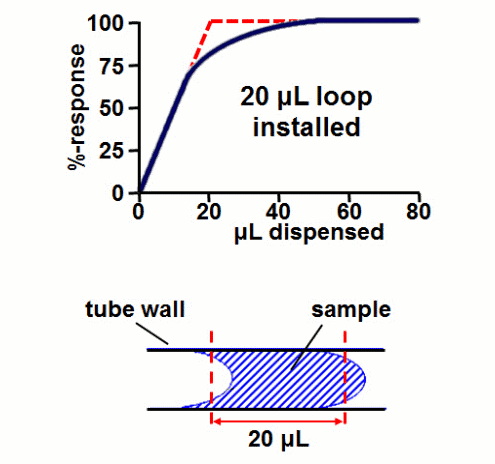This discussion follows on the last HPLC Solutions instalment (HPLC Solutions #118), where we discussed the relative merits of manual injectors and autosamplers. A little better understanding of the loop filling characteristics will help us realize why injection volumes aren’t always accurate and why autosamplers tend to be more precise than manual injection.
Let’s assume that we have an injection valve with a 20 µL loop installed on it. It would seem logical that if we dispensed >20 µL of sample into that loop that we would completely fill the loop and the injection volume would be constant. Similarly, if we were to push 15 µL into the loop, we would expect a response that is 75% of the filled loop. Right? Wrong! The blue line in the top sketch of the figure shows the volume that actually is delivered, whereas the dashed red line shows what is expected. You can see that somewhere above 10 µL the response begins to be non-linear, and this non-linearity extends to >40 µL. This is not at all what we expected.
The problem with sample loop filling has to do with the laminar flow process that takes place when liquids pass through tubing, as illustrated at the bottom of the figure. Because of friction along the walls of the tubing, the injected sample plug tends to take on a bullet-shaped profile. The tip of this plug travels approximately twice as fast as the molecules at the wall. This means that if we precisely measure 20 µL of sample and push it into a 20 µL sample loop, some of it passes out of the loop before the last of it reaches the loop inlet. This is seen by the way the blue sample plug fits within the dashed red lines representing the ends of the loop. The volume of sample remaining in the loop is difficult to calculate, because there are additional complications of fittings, corners, and other surface imperfections inside the injector that further disturb the flow stream. The bottom line is that somewhere >50% of the loop volume up to 2-3 times the loop volume, non-linear filling behavior is common. This means that if you are going to use a partially filled sample loop, it is best to stay below about half of the loop volume if you are expecting linear behavior. Similarly, if you want to use a filled-loop injection, push at least three times the loop volume through it. And with over-filling the loop, it is best to keep the same volume of overfill each time for best results. For example, with at 20 µL loop, stay with 75 µL every time instead of 60, 80, 70, and so forth.

Autosamplers have a precision advantage over manual injection because the mechanism that drives the syringe is highly precise – much better than you can do by hand with manual injection. The result is very low imprecision – typically <0.5% RSD for peak area on 6 replicate injections. Accuracy is another issue, but personally I’m not so concerned about accuracy. If I set the autosampler to inject 20 µL, I don’t care if it injects 18 µL or 21 µL, as long as it injects the same amount every time. This is because I always inject the same volume of both reference standards and samples, so the volume accuracy is canceled. The highly precise sample delivery mechanism of the autosampler means that even if the volume is not correct, it is the same every time.
This blog article series is produced in collaboration with John Dolan, best known as one of the world’s foremost HPLC troubleshooting authorities. He is also known for his research with Lloyd Snyder, which resulted in more than 100 technical publications and three books. If you have any questions about this article send them to TechTips@sepscience.com




